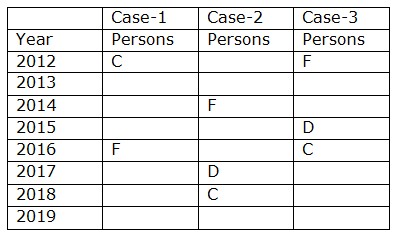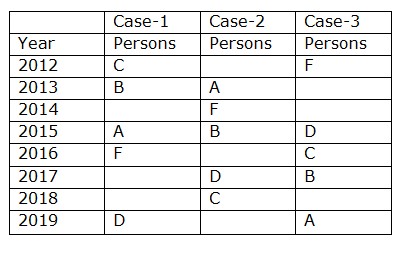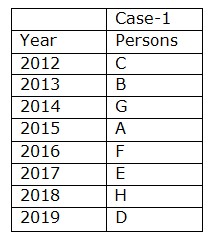Question
If C is related to 2015 and F is related to 2019 in a
certain way, then G is related to which of the following year? Study the following information carefully and answer the questions given below. Eight persons A, B, C, D, E, F, G and H completed Army training in eight different years viz. 2012 to 2019, but not necessarily in the same order. D completed the training three years after F. Only three persons completed the training between C and F. C doesn’t complete on an odd numbered year. The number of persons completed before D is one more than the number of persons completed after B. Only one person completed the training between B and A. The difference between the years in which G and E completed is three years. Both H and E completed the training in consecutive years.Solution
We have, D completed the training three years after F. Only three persons completed the training between C and F. C doesn’t complete on an odd numbered year. From the above condition, there are three possibilities  Again we have, The number of persons completed before D is one more than the number of persons completed after B. Only one person completed the training between B and A.
Again we have, The number of persons completed before D is one more than the number of persons completed after B. Only one person completed the training between B and A.  Again we have, The difference between the years in which G and E completed is three years. Both H and E completed the training in consecutive years. So Case2 and 3 get eliminated, hence the final arrangement becomes
Again we have, The difference between the years in which G and E completed is three years. Both H and E completed the training in consecutive years. So Case2 and 3 get eliminated, hence the final arrangement becomes 
लेखक के अनुसार घटिया नागरिक कौन है?
"सक्षम ” शब्द के लिए सटीक अँग्रेजी अनुवाद होगा?
लेखक के अनुसार देश का अस्तित्व कब दाँव पर लग जाता है –
(1) कुछ रसायन उस पीढ़ी को
(य) जो उसके सम्पर्क में रहत�...
निम्नलिखित में से “ बहिष्कृत ” शब्द का अंग्रेजी अनुवाद हो�...
“सांस्कृतिक बाधाओं” का अंग्रेजी अनुवाद क्या होगा?
...नीचे कुछ वाक्य दिए गए हैं। यदि दिए गए वाक्यों को एक उचित क्...
(1) मोहनदास करमचंद गांधी और माओ
( य ) के अनन्तर में
( र ) न�...
आदर्श नागरिक से लेखक का क्या अभिप्राय है ?
10
Relevant for Exams:


